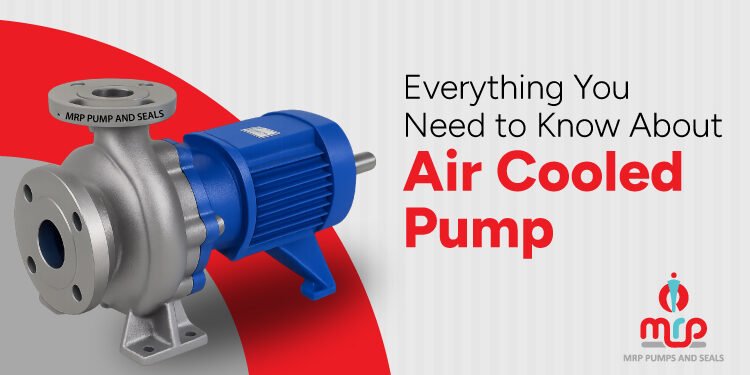Introduction
When it comes to handling high-temperature fluids in industrial processes, choosing the right pump can make or break your operation’s efficiency. Air cooled pumps have emerged as a game-changing solution for industries dealing with thermal fluids, hot oils, and elevated temperature applications.
Whether you’re a plant manager evaluating pump options or an engineer designing a new system, understanding air cooled pump technology is crucial for optimal performance. This comprehensive guide covers everything from basic functionality to advanced applications, helping you make informed decisions for your industrial pumping needs.
What is an Air-Cooled Pump and How Does It Work?
An air-cooled pump is a specialized industrial pump designed to handle high-temperature fluids using ambient air for cooling instead of traditional water-based cooling systems. These pumps excel in applications where fluid temperatures reach up to 350°C, making them perfect for chemical processing, thermal power, and manufacturing facilities.
Unlike conventional pumps that rely on external cooling water systems, air-cooled pumps feature integrated air-cooling mechanisms that eliminate the need for cooling water infrastructure. This design addresses critical challenges including water scarcity, poor cooling water quality, and environmental compliance requirements.
The technology is particularly relevant for industrial facilities facing water availability issues, high water costs, or strict environmental regulations. Air-cooled pumps provide a complete solution for high-temperature applications while addressing operational challenges of water dependency and maintenance complexity.
Key Insight: Air-cooled canned motor pumps provide reliable thermal management without external cooling water, making them ideal for water-scarce regions and environmentally conscious facilities.
Discover MRP’s Air-Cooled Pump Range
How Does MRP Air-Cooled Technology Solve Industrial Problems?
MRP Pumps has developed advanced air-cooled canned motor pump technology specifically designed for high-temperature industrial applications. The innovative design isolates liquid in the motor section from hot process fluid through pressure ports in the front bearing housing.
Core Design Features
The system circulates isolated liquid (typically the same as pumped fluid) through an air-cooled heat exchanger using an auxiliary impeller on the rotor assembly. This ensures the motor and bearing environment operates at much lower temperatures than the process fluid, enabling standard motor components while significantly reducing costs.
Technical Specifications
Operating Parameters:
- Capacity: Up to 300 m³/hr
- Head: Up to 150 MLC
- Pump Size: DN 25mm to 300mm
- Speed: 1450/2900 rpm at 50 Hz, 3500 rpm at 60 Hz
- Temperature: Up to 350°C maximum
Major Advantages
- Standard Components: Uses standard motor insulation and bearings due to effective cooling design
- Lower Temperatures: Bearing environment operates at significantly reduced temperatures
- Secondary Containment: Canned motor design provides additional safety layer
- Water Quality Independence: Eliminates fouling concerns from poor water quality
- Monitoring Capability: Bearing wear monitors available for predictive maintenance
Download MRP Air-Cooled Pump Catalogue
Why Choose Air-Cooled Pumps Over Traditional Options?
Air-cooled canned motor pumps offer compelling benefits that make them increasingly preferred for industrial applications worldwide.
1. Do Air-Cooled Pumps Work Without Water?
The most significant advantage is the complete elimination of cooling water requirements. This provides operational continuity regardless of water availability, eliminates water treatment costs, and removes concerns about cooling water quality that can cause scaling, corrosion, and fouling in conventional systems.
2. Are Air-Cooled Pumps More Cost-Effective?
Air-cooled pumps reduce overall system energy consumption by eliminating cooling water pumps, cooling towers, and water treatment equipment. The simplified system design results in lower maintenance requirements and reduced operational complexity, addressing challenges of skilled personnel availability.
3. How Do Air-Cooled Pumps Help with Environmental Compliance?
These pumps help facilities comply with increasingly stringent environmental regulations including Zero Liquid Discharge (ZLD) requirements and water conservation mandates. The water-independent operation supports sustainability goals and simplifies environmental clearance processes for new projects.
4. Are Air-Cooled Pumps More Reliable Than Water-Cooled?
Canned motor design eliminates mechanical seals, reducing leakage risks and maintenance requirements. The integrated cooling system provides consistent performance across varying ambient conditions while maintaining optimal operating temperatures for critical components.
Important: The combination of these benefits typically results in 18-24 month payback periods for most industrial applications.
Ready to start saving? Contact MRP for Application Analysis
Air-Cooled vs Water-Cooled: Which Pump is Better?
| Parameter | Air-Cooled Pump | Water-Cooled Pump |
| Cooling Method | Ambient air circulation | Continuous water supply |
| Water Dependency | Completely independent | Requires 15-50 L/min |
| Installation | Simple, no water infrastructure | Complex piping systems |
| Maintenance | 40-60% lower costs | Regular water treatment needed |
| Operating Costs | Lower energy consumption | Higher auxiliary equipment costs |
| Environmental | Supports ZLD compliance | Water discharge requirements |
| Space Requirements | Compact installation | Additional cooling equipment |
| Initial Investment | Lower total installed cost | Higher infrastructure costs |
Decision Guidelines
Choose Air-Cooled When:
- Water availability is limited or expensive
- Environmental regulations restrict water usage
- Simplified maintenance is priority
- Remote locations with limited infrastructure
Consider Water-Cooled For:
- Extremely high thermal loads (>500 kW)
- Continuous ambient temperatures above 45°C
- Existing well-maintained water infrastructure
How to Select the Right Air-Cooled Pump for Your Application?
What Size Air-Cooled Pump Do I Need?
Step 1: Application Assessment Determine your primary application – thermal oil circulation, chemical processing, or heat transfer systems. MRP canned motor pumps handle temperatures up to 350°C for most industrial thermal applications.
Step 2: Capacity Requirements
- Small systems (up to 50 m³/hr): DN 25-80mm pumps
- Medium systems (50-150 m³/hr): DN 80-150mm pumps
- Large systems (150-300 m³/hr): DN 150-300mm pumps
Step 3: Operating Conditions Consider fluid temperature range, chemical compatibility, and ambient conditions. Ensure pump materials are suitable for your specific application requirements.
What Should I Consider When Buying an Air-Cooled Pump?
Process Parameters: Maximum operating temperature, flow rate requirements, system pressure conditions, and fluid properties including viscosity and chemical compatibility.
Environmental Factors: Ambient temperature range, available installation space, electrical supply requirements, and environmental compliance needs.
Economic Considerations: Total cost of ownership including initial investment, operating costs, maintenance requirements, and expected payback period.
Need expert selection assistance? Get Consultation from MRP Technical Team
What Are the Best Industrial Applications for Air-Cooled Pumps?
Air-cooled canned motor pumps serve diverse applications across multiple industrial sectors, demonstrating their versatility and reliability.
1. Chemical and Pharmaceutical Industries
These industries require precise temperature control and contamination-free operations. Air-cooled pumps handle aggressive chemicals while maintaining sterile conditions without water contamination risks.
Common Applications: Reactor heating systems, solvent recovery processes, thermal fluid circulation in API manufacturing, and equipment cleaning systems requiring high-temperature operation.
2. Textile and Food Processing
Manufacturing facilities benefit from air-cooled technology for maintaining product quality while addressing water scarcity challenges.
Applications include: Dye bath circulation systems, thermal oil circulation in fabric finishing, food sterilization processes, and cooking oil circulation in large-scale production facilities.
3. Power Generation and Heavy Industries
Thermal power plants and heavy manufacturing use air-cooled pumps for auxiliary applications where water conservation is increasingly important.
Typical uses: Auxiliary heating systems, fuel oil circulation, lubrication oil heating, and waste heat recovery applications in various industrial processes. zing.
4. Heat Transfer Systems
Industrial energy efficiency initiatives drive demand for effective heat transfer applications where air-cooled pumps provide precise flow control essential for optimal performance.
How to Install and Maintain Air-Cooled Pumps Properly?
1. How to Install Air-Cooled Pumps Correctly?
- Positioning Requirements: Install pumps with adequate air circulation around cooling fins. Maintain minimum clearances of 1 meter on air intake side and 0.5 meters on other sides for optimal performance.
- Foundation Considerations: Ensure proper foundation design accounting for local soil conditions. Provide adequate drainage and weather protection for electrical components in outdoor installations.
- Environmental Factors: Consider ambient temperature, humidity, and air quality. Install air intake filters in dusty environments and provide corrosion protection in coastal areas.
2. How Often Do Air-Cooled Pumps Need Maintenance?
- Daily Monitoring: Check bearing temperatures, cooling fin cleanliness, and listen for unusual noises during operation.
- Weekly Service: Clean cooling fins, inspect electrical connections, and verify proper lubrication levels.
- Monthly Maintenance: Comprehensive cleaning of heat exchange surfaces, bearing condition checks, and safety system testing.
- Annual Overhaul: Complete inspection including impeller and bearing replacement, seal replacement, and performance verification testing.
3. What Problems Can Occur with Air-Cooled Pumps?
Common issues include overheating due to fouled cooling fins, reduced flow from impeller wear, and vibration from misalignment. Most problems can be prevented through regular maintenance and proper operating procedures.
Pro Tip: Establish predictive maintenance using vibration monitoring and thermal imaging to identify potential issues before they cause downtime.
What is the Cost and ROI of Air-Cooled Pumps?
1. Investment Analysis
Air-cooled pumps typically have higher initial costs but lower total installed costs due to eliminating cooling infrastructure. The simplified installation reduces labor costs and project timelines significantly.
Cost Benefits:
- No cooling tower or heat exchanger installation
- Reduced piping and electrical work
- Faster commissioning and startup
- Lower civil construction requirements
2. Operating Cost Savings
Annual Savings Include:
- Elimination of cooling water costs
- Reduced maintenance expenses
- Lower energy consumption
- Simplified operations and reduced labor
ROI Timeline: Most installations achieve payback within 18-24 months through operational savings and reduced maintenance costs.
3. Long-Term Value
Air-cooled pumps provide protection against rising water costs, environmental compliance expenses, and operational risks related to water availability and quality issues.
Note: Actual costs vary based on application requirements and local conditions. Detailed feasibility studies are recommended for major installations to accurately assess economic benefits.
Are Air-Cooled Pumps Reliable and What Standards Do They Meet?
1. Compliance Requirements
Air-cooled pumps should comply with relevant international and local standards, including ISO 5199 for centrifugal pumps, API 610 for petroleum applications, and BIS standards for industrial equipment.
Safety Certifications: ATEX and IECEx certifications should be available for hazardous area applications, ensuring safe operation in explosive atmosphere environments.
2. Testing and Validation
Factory Acceptance Testing includes:
- Performance verification across operating range
- Hydrostatic pressure testing at 1.5x design pressure
- Vibration and noise level measurement
- Material certification and traceability
Quality Assurance: ISO 9001 certified manufacturing processes ensure consistent quality and reliability for all pump installations.
What Technical Support is Available for Air-Cooled Pumps?
1. Engineering Services
MRP Pumps provides comprehensive application engineering including process analysis, system design, and performance optimization for specific industrial requirements.
Support includes: Site assessment, retrofit analysis, system integration assistance, and custom design services for unique applications.
2. Installation and Service
On-Site Services
- Installation supervision and commissioning
- Performance testing and system optimization
- Operator training and maintenance support
- Emergency response and troubleshooting assistance
3. Ongoing Support
Regional service network provides local support with spare parts inventory, preventive maintenance programs, and technical consultation for system optimization and upgrades.
Conclusion
Air-cooled canned motor pumps offer a proven solution for high-temperature industrial applications while eliminating cooling water dependency. The technology provides significant economic benefits through reduced operating costs, simplified maintenance, and environmental compliance support.
MRP Pumps combines advanced technology with comprehensive support services to ensure successful implementation and long-term reliability for diverse industrial applications.
Ready to Transform Your Operations?
MRP Pumps provides:
- Proven air-cooled pump technology
- Comprehensive technical support
- Competitive solutions for industrial applications
- Local service and support network
Get Started Today:
Common Questions About Air-Cooled Pumps
MRP air-cooled pumps handle fluid temperatures up to 350°C maximum, suitable for most thermal oil and high-temperature industrial applications.
No, they require significantly less maintenance by eliminating water-related issues like scaling, corrosion, and fouling, resulting in 40-60% lower maintenance costs.
Most installations achieve payback within 18-24 months through eliminating cooling water costs, reduced maintenance, and improved energy efficiency.
Yes, they can be constructed with corrosion-resistant materials including stainless steel and special alloys for aggressive chemical applications.
MRP pumps are available with capacity up to 300 m³/hr and head up to 150 MLC, covering small to large industrial applications.
They are designed for ambient temperatures up to 45°C and can operate effectively in most industrial environments with proper installation.
ATEX and IECEx certifications are available for explosive atmosphere applications in the chemical and petroleum industries.
Yes, MRP maintains local inventory of critical spare parts with rapid delivery to minimize downtime for industrial operations.




